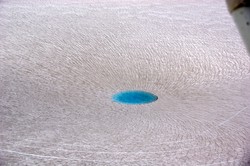On the micro-earthquake activity at Mýrdalsjökull
Monitoring statement with regard to the Katla volcano
The following summary by the Icelandic Meteorological Office is about a recent increase in earthquake activity at the ice-covered Katla volcano, Iceland. Media interest in Iceland's volcanoes has remained high since the Eyjafjallajökull eruption of 2010, hence the summary is intended as an official monitoring statement, in case of diverging media reports.
Micro-earthquake activity
Since mid-June, earthquake activity within the caldera of the ice-covered Katla volcano has increased above background levels. More than 100 shallow-seated earthquakes have been detected in Katla caldera since 1 June 2016, which is almost four times the monthly average compared to previous years. Earthquakes occurred mainly in bursts ranging from minutes to hours, often with 20 events or more. The two largest earthquakes since the unrest began occurred on 26 July at 03:42 and 03:50 UTC, respectively, both with a magnitude of Mw3.2.
Such summertime increases in seismicity are common at Katla and the ongoing activity within the caldera is similar to summertime unrest observed in 2012 and 2014. Often this increased seismicity occurred in association with drainage of meltwater from several known ice-cauldrons, formed due to hydrothermal activity, as observed almost annually. Since late June 2016 there have been three small floods in Múlakvísl river, an outlet from Mýrdalsjökull, in addition to a flood from the Entujökull glacier. Presently, water-level and electrical conductivity measurements at the bridge over Múlakvísl show increased drainage of geothermal meltwater from Mýrdalsjökull - the ice-cap overlying Katla. We have received several reports throughout the summer of a hydrogen sulphide stench from glacial rivers around Myrdalsjökull.
Around Katla we are not detecting signs of increased ground deformation or bursts of seismic tremor, which are both signals that might indicate movement of magma. We continue to monitor Katla closely and will issue updates on IMO‘s web-site if the situation intensifies. Our assessment is that the volcano is in a period of summertime unrest and it does not show signs of impending eruption, although we cannot rule-out a sudden escalation in seismicity in connection with a hazardous flood.
On-line overview of seismicity levels within the caldera is available.
An overview of the Katla volcanic system is given in the Catalogue of Icelandic Volcanoes.




